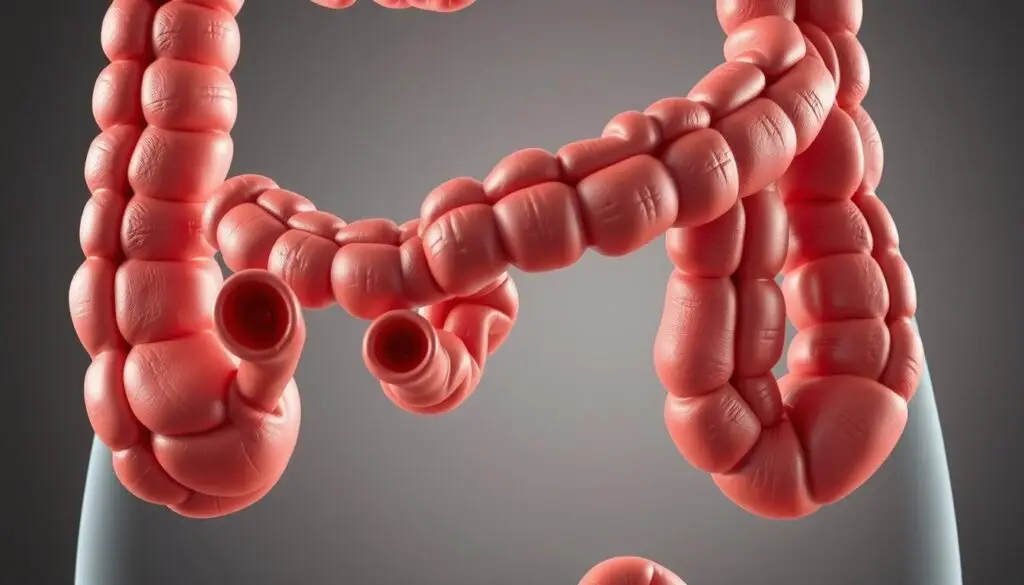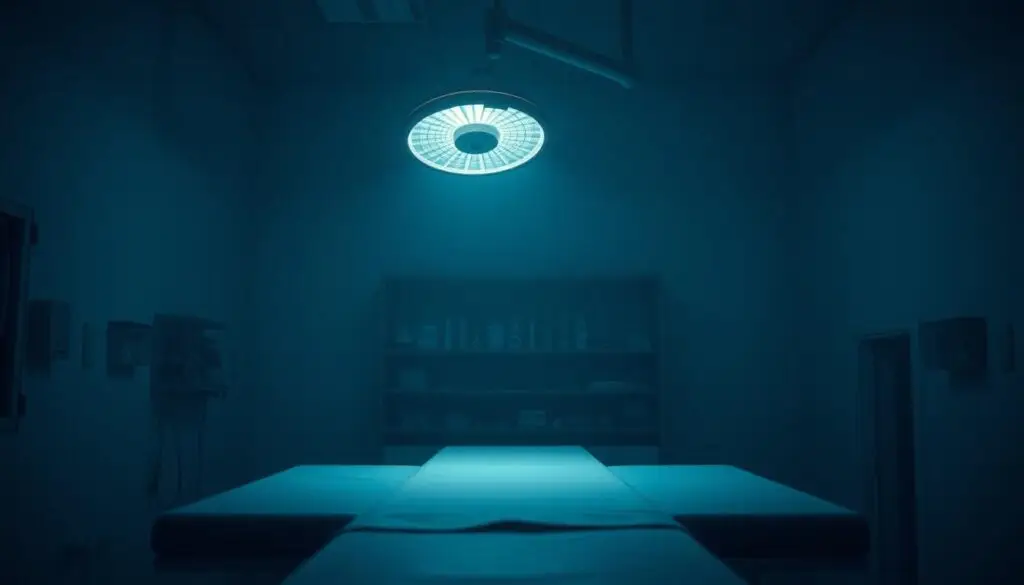This short guide helps you spot changes that matter. Many cases of colon cancer begin as tiny polyps that cause no pain. Finding issues sooner gives you a much better chance for simple treatment and strong outcomes.
Watch for small but persistent changes in your bowel routine, stool, or energy. Symptoms can include shifts in frequency, visible blood, or unexplained weight loss. These hints often come before serious disease develops.
Screening usually starts at age 45 for those at average risk. If you have a higher risk, talk with your clinician about earlier checks and options like stool-based tests or colonoscopy. Learn more from trusted resources like the Mayo Clinic overview.
Key Takeaways
- Small polyps in the colon can grow into cancer but are often removable.
- Noticeable changes in bowel habits or blood in stool warrant prompt attention.
- Screening at 45 is standard; consider earlier testing with higher risk.
- Colonoscopy is usually painless and takes about 30–40 minutes under anesthesia.
- Noninvasive stool tests offer alternate screening if you defer colonoscopy.
Why recognizing colorectal cancer symptoms early matters right now
Acting quickly when subtle symptoms appear often means treatment is simpler and more effective. More than 90% of people with early-stage colon disease survive five years after diagnosis. That makes spotting changes urgent.
Mild shifts in bowel habits, new fatigue, or vague pain can be meaningful. These early symptoms may be quiet at first, so noticing small differences in your routine matters.
- Quick attention shortens the path to care and limits progression.
- Screening can find and remove precancerous polyps before they become cancer.
- Knowing your health history helps you spot true change and act with confidence.
| Stage at Detection | Typical Outcome | Why time matters |
|---|---|---|
| Stage I | High five-year survival (>90%) | Treatment is often less invasive |
| Stage II–III | Moderate survival, more treatment | Delays can require chemo or surgery |
| Stage IV | Lower survival, complex care | Advanced disease needs aggressive therapy |
Spotting warning signs quickly reduces risk and preserves quality of life. Speak up to your clinician if anything feels different from your normal.
Early Signs of Colon Cancer You Need to Know
When stool shape, frequency, or comfort changes and won’t settle, it deserves attention. Small shifts can be the first clue that something in the colon has changed.

Track persistent diarrhea, constipation, or thin, ribbon-like stools. These may signal narrowing from a tumor and should not be ignored if they last more than a few days.
Urgency and incomplete emptying
Feeling a strong urge but passing only small movements, or always feeling not fully emptied, is a pattern worth noting. Log frequency and shape so your clinician can compare trends.
Visible or dark blood in stool
Bright red blood in the toilet or black, tarry stool both require prompt evaluation. Hidden bleeding can show up on a fecal occult blood test and change next steps.
Pain, weight loss, and fatigue
Ongoing abdominal cramping, bloating, unexplained weight loss, or low energy can accompany bowel changes. These may reflect bleeding, nutrient loss, or obstruction and should prompt an exam.
- Keep a simple log of bowel movements, stool shape, and any blood.
- If patterns persist, share your notes and consider screening options like a fecal test or colonoscopy.
| Symptom | What it may mean | Action |
|---|---|---|
| Thin/ribbon stools | Possible narrowing from a tumor | Document and see your clinician |
| Bright red or black stool | Active or digested bleeding | Seek prompt evaluation and consider fecal testing |
| Persistent cramping or bloating | Irritation or partial obstruction | Medical review and imaging if needed |
| Unexplained weight loss/fatigue | Systemic effects of disease or blood loss | Blood tests and follow-up care |
For more details on tracking these developments and next steps, see this guide on bowel cancer indicators.
When it’s not cancer: conditions with similar symptoms
Symptoms that worry you often come from common, treatable conditions. Still, clear evaluation helps rule out colorectal cancer and lowers your risk of missed diagnosis.

Hemorrhoids and anal fissures
Bright red bleeding on toilet tissue or on the stool usually points to hemorrhoids or fissures.
These conditions cause visible bleeding near the rectum and often pain with bowel movements.
Irritable bowel and inflammatory bowel disease
Irritable bowel can cause alternating diarrhea and constipation with cramping. IBD causes more persistent inflammation and may bring weight loss or anemia.
Both can mirror cancer-related changes, so you should see a doctor when symptoms persist.
- Watch patterns: recurring bleeding, lasting constipation, or worsening pain are warning signs.
- Discuss triggers: diet, stress, and bowel history help separate a functional condition from structural problems.
- Only testing can tell: stool checks, imaging, or colon exam confirm the cause.
| Common condition | Typical finding | When to see a doctor |
|---|---|---|
| Hemorrhoids | Bright red bleeding, local pain | If bleeding recurs or pain worsens |
| Anal fissure | Sharp pain with bowel movements | When pain prevents normal bowel habits |
| Irritable bowel | Cramping, constipation or diarrhea | If symptoms disrupt life or change |
| Inflammatory bowel disease | Chronic pain, bleeding, weight loss | Urgent evaluation and tests |
Your risk factors: what you can and can’t control
Knowing which risks you can change and which you can’t helps you act with purpose. Start by noting key influences on colon cancer and how they affect screening and prevention.
Age and race
Incidence climbs with age: most cases occur after 55, and the median diagnosis is 66. That trend is why screening at 45 is recommended for many people.
African Americans face higher rates of colorectal cancer, so timely screening and tailored care are especially important.
Family history and genetics
If a parent, sibling, or child had colorectal polyps or colon cancer, your screening timeline may shift earlier.
About one in four people with colorectal cancer report a family history. Share this detail so your provider tailors testing.
Lifestyle and daily habits
Modifiable factors matter: choose more fiber, limit red and processed meats, avoid tobacco, cut back on alcohol, move regularly, and manage weight.
- Checklist for your visit: age, race, family, recent changes, and daily habits.
- Tell your clinician about inflammatory bowel disease or genetic concerns so screening fits your true risk profile.
From symptoms to action: when to call your doctor
New or persistent symptoms that disrupt your daily life are a clear reason to contact your clinician. Do not wait when bleeding, steady pain, or lasting changes in bowel movements appear.
Red flags you should not ignore include rectal bleeding, black or tarry stool in the toilet, ongoing changes in bowel movements, unrelieved abdominal pain, fatigue, and unexplained weight loss. If any of these last more than a couple of weeks, book an appointment.
Red flags that warrant an appointment now
- New or ongoing rectal bleeding or dark blood visible in the toilet.
- Bowel movements that change and don’t return to normal.
- Persistent abdominal pain, growing fatigue, or unexplained weight loss.
What your provider may do next: stool tests, exams, and referrals
Your doctor will review your history, assess your personal risk, and likely begin with a simple stool test for hidden blood. A physical exam helps identify local tenderness or other clues.
If initial checks suggest further review, your provider may refer you for a colonoscopy. Fast evaluation can shorten time to diagnosis and get you faster care if needed.
| Red flag | Likely first steps | Possible follow-up |
|---|---|---|
| Visible rectal bleeding | History and exam; fecal occult blood test | Colonoscopy if bleeding persists |
| Black/tarry stool in toilet | Stool blood test; blood work for anemia | Urgent referral for colon evaluation |
| Persistent bowel changes or pain | Symptom log review; physical exam | Imaging or endoscopy based on findings |
Prepare a concise log with timing, frequency, stool appearance, pain level, and any blood before your visit. Clear notes help your doctor pick the right test and plan.
For more detailed guidance on symptoms and next steps, see this resource on signs and symptoms.
Screening and diagnosis: how you get answers and peace of mind
A planned screening schedule brings peace of mind and real protection against progression. Start by talking with your doctor about when to begin testing based on your history and family history.
When to start screening and how often based on your risk
For most people, screening begins at age 45. If you have a family history, genetic conditions, or inflammatory bowel disease, testing should start earlier.
Work with your clinician to set intervals. Frequency may change based on prior findings, polyps, or other risk factors.
Colonoscopy basics: anesthesia, painless polyp removal, and quick procedure time
Colonoscopy examines the colon and rectum while you are under anesthesia. The colon itself lacks pain nerves, so the exam and polyp removal are painless while you’re asleep.
The procedure usually takes about 30–40 minutes. Your doctor uses a camera to find and remove precancerous polyps during the same visit.
Non-invasive options and fecal occult blood tests
Stool-based tests, such as fecal occult blood testing, offer a noninvasive alternative if you prefer to delay colonoscopy. These tests detect hidden blood in stool and guide next steps.
If a stool test is positive, a colonoscopy is the recommended follow-up for diagnosis and treatment.
| Screening option | What it checks | When it’s used |
|---|---|---|
| Colonoscopy | Direct exam of colon and rectum; polyp removal | Standard if screening due or stool test positive |
| Fecal occult blood test | Hidden blood in stool | Noninvasive option; repeat annually or per doctor |
| Stool DNA test | Genetic markers and blood in stool | Every 1–3 years per test type; positive requires colonoscopy |
Screening at the right time finds abnormalities at early stages when outcomes are best. Choose the test that fits your life, discuss it with your doctor, and make a plan that keeps your body and future well.
Conclusion
Small, persistent changes in bowel habits, visible or hidden bleeding, unexplained weight loss, or new fatigue are reasons to act. Track what you notice and share a clear log with your doctor so the right tests happen faster.
Your risk shifts with age, family history, and daily habits. Improve factors you can control: more fiber, less processed meat, steady activity, limited alcohol, and no tobacco.
Book an appointment if symptoms persist, discuss conditions like irritable bowel that can mimic disease, and commit to screening on time—usually starting at 45 or earlier when family risk applies. Partner with your care team and move forward with confidence.



